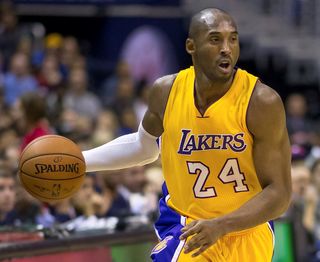Fear
The Mamba Mentality
Peak performance lessons from Kobe Bryant.
Posted January 29, 2020 Reviewed by Devon Frye

Sunday was a sad day for Angelinos. We lost one of our basketball legends in Kobe Bryant.
Kobe had completed an amazing 20-year career as an all-time best in the NBA. He had then embarked on his second chapter, already winning an Oscar for the animated short “Dear Basketball” based on a poem he wrote. Last night, the Empire State Building was lit up in the Lakers’ purple and gold.
As someone who works with elite athletes, I’m curious about what makes them stand out. What’s their mindset? What routines and work-ethic have they developed to achieve the pinnacle of success? And what can we learn from these approaches—even if our goals are not so lofty?
Kobe had a very defined approach to life that he referred to as “Mamba Mentality.” He once said, “If you see me in a fight with a bear, pray for the bear.” He was fearless and went all-out. He didn’t leave anything to chance and was committed to preparing more than anyone else.
Few of us can consistently match the intensity that Kobe demonstrated. How can you keep your sanity and balance in life and still utilize some of the lessons from this great player? In my Nine Pillars of Resilience and Success, the eighth pillar is flexibility. If you learn and apply Kobe's lessons some of the time—when they can have an important impact in your life—you might be willing to aspire to this. In other words, by being flexible in your approach to life, you can, when it’s strategic, shift into the Mamba Mentality.
Considering it? Let’s look at some of the ingredients of Kobe’s approach.
Preparation, Persistence, and Curiosity
In an interview with Lewis Howes, host of The School of Greatness podcast, Bryant revealed that when he played summer league in Philadelphia at age 11, he went an entire season without scoring a point. “Not a free throw, not a lucky bounce, nothing.” He recalled, “I had to work on the basics, the fundamentals”—reminiscent of the legendary coach John Wooden. When others were practicing an hour twice a week, he was practicing a couple of hours every day. And his practices were systematic: taking one shot from one location hundreds of times. “It’s a simple thing of math—the more time you put into it, the better you get.” By age 14, he was the best player in the state.
As a professional, he took this preparation to another level, as noted by sportswriter Zach Lowe: “Bryant practiced every skill within a skill, every trick of footwork, every post-up move, and watched enough film to know how to deploy them in specific situations against specific opponents.”
The notion of specific skills against specific opponents is a strategy that set him apart. He studied all of his opponents and knew their tendencies. A contemporary of Kobe’s, known as a great defensive player with fast hands, was intent on showing Kobe that he could stop him. During that game, as Kobe was about to make a move, this player—with lightning speed—reached in and stole the ball. The next time these two played, a similar situation occurred, where the other player made a similar move, with Bryant in the identical position. He swiped… but the ball was somewhere else. Kobe gave a knowing smile and told him, “You weren’t going to do that to me twice.”
Kobe adjusted from player to player based on studying how they played and doing his homework. How does this relate to you and achieving your goals? What part of this approach can you take away and use for yourself? Where can you up your game and be a peak performer?
There are, for example, important lessons for me personally. I’ve been interviewing pioneers of biofeedback and know I can be more prepared for these meetings. I can learn more about those I’m interviewing so I pose better questions. Also, I can apply his approach to practicing my saxophone. I can practice scales repeatedly until perfect, and of course, practice more frequently. As I focus on Kobe and Mamba Mentality, I’m inspired to take on these challenges. What challenges might you rise for?
In an article by sportswriter Ramona Shelburne, she recalled that Kobe “reached out to athletes across all sports. He cold-called writers like J.K. Rowling, wanting to talk storytelling. Business leaders, actors, musicians, directors. And he didn't just call them. He called them every day, sometimes three times a day. Hounded them. Just trying to understand what made them great and absorb whatever knowledge or inspiration they would give to him.” Jerry West, another Lakers legend, noted this same quality when Kobe was signed at age 17. This demonstrated another quality of peak performers: curiosity combined with persistence. Kobe was insatiable in pursuing his passions and his interests and learning as much as he could.
Again, how can you apply this approach? What can you be curious and persistent about that can move you closer to your goals?
Commitment to Excellence
Zach Lowe wrote, “I admired him for going for it. He took big swings. He would accept failure, even humiliation. He would not blend in.” When Bryant had that terrible experience of not scoring a point, his father saw him crying and gave him a hug and said, “Whether you score zero points or 60, I’m going to love you no matter what.” Kobe said that gave him the confidence and security to fail—but quickly noted that he was going for the 60! As Lowe noted, “That is how he played, too, and that is why everyone—fans, players, media—were so drawn to him.”
Few of us have or had a father who was so reassuring. But you cannot let that stop you. In my book, The Path: Mastering the Nine Pillars of Resilience and Success, the first pillar is your relationship with yourself: how you talk to yourself and how you treat yourself. If you did not get good support growing up, you must find a healthy way to compensate for it now.
Childhood lessons get translated into our own internal voice, or internal parent. You may be starting out with a very critical internal parent; a voice that isn’t supportive. This can create self-doubt and interfere with performance. You want to identify what a healthy parent sounds like: loving, caring, supportive, accepting, and compassionate.
Whether you are used to hearing an internal critic or not, begin speaking like Kobe’s father—from a place of love and acceptance. Begin training yourself to be kind and accepting who you are. Tell yourself it’s OK to make mistakes in the pursuit of higher goals. As Kobe said, do the math—if you go for it, you are more likely to be successful.
Fire and Passion
In sports, there are frequent references to the "killer instinct." Kobe said, “I always aimed to kill the opposition.” When he walked onto the court, it was serious business with no letup. He and LeBron James, another NBA great, played in the Olympics together. “At the Olympics, the main thing LeBron and I discussed was what constitutes a killer mentality. He watched how I approached every single practice, and I constantly challenged him and the rest of the guys.”
“I remember there was one half when we were messing around. I came into the locker room at half-time and asked the guys—in a less PG manner—what in the hell we were doing. In the second half, LeBron responded in a big way—he came out with a truly dominant mindset. And I’ve seen him lead that way ever since.”
Some people may shy away from this reference to a "killer mentality" and wanting to "dominate." But this is the approach that literally creates change in your brain! Our brains, just like our behaviors fall into patterns and ruts. We keep repeating bad habits and stay stuck. It’s only when we mobilize to new levels that we wake up the brain, “Hey, I’m not going to settle for the same old way.”
This is related to my seventh pillar of resilience: presence. It’s important to awaken to the moment if you want to grow and be a peak performer. Otherwise, you’ll keep acting in the same old pattern, like a train locked onto its tracks. When you mobilize your passion and awaken to the moment, your brain responds by creating new nerve pathways. As my old colleague D.O. Hebb said, “neurons that fire together, wire together.”
Shelburne wrote about Kobe, “He wasn't fearless. He had fears like everyone else. He just learned how to will himself past fear. Or maybe just how to scoff at it. 'To a certain extent, every day I was vulnerable,' he told me once. 'You're always dealing with fear, with something in your imagination. Something that you think can happen.'”
One take-away is that fear is normal even in high achievers, but it doesn’t have to stop you. So feel the fear and do it anyway. This will create your greatest achievements.
Spread the Wealth: Giving Back
This is an attribute that you don’t always find in the elite athlete, but Kobe had it. I just learned, for example, that he satisfied over 200 wishes for the Make-a-Wish foundation in the last couple of years. Now, I want to add this to my version of peak performance attributes. Being in the “flow state” involves moving the energy—in this case, sharing the gifts you were blessed with and giving back. This is an expression of gratitude.
In an interview with Shelburne in 2016, he said: "Some people want to take it with them to the grave. Like 'Lord of the Rings.' The world is filled with a lot of Smeagols [who] can't let go of the damn ring. I enjoy passing things on.”
And he liked seeing others do great things: "People who I know are passionate about what they do," he explained. "I just like seeing them do great things. That's what I enjoy." Magic Johnson, another NBA great, recalled, “He gave his knowledge, time, and talent to tutor so many at the youth level, collegiate level, and NBA and WNBA players. Words can’t express the impact that he had on the game of basketball.” Again, how can you take this as an example of how to live your life as a peak performer?
Conclusion
It’s helpful to recall Joseph Campbell and his work on the “Hero’s Journey,” in which the hero goes out into a supernatural world, encounters various forces that he or she conquers, and, in the process, grows and transforms themselves; returning to share this transformation with others.
Every one of us, if we are conscious, recognizes that in our lives, we live out our own hero’s journey. We strive to overcome childhood wounds. We strive to overcome obstacles and adversity. And ultimately, we strive to transform ourselves and create meaning out of our lives. We can all take the challenge of our journey and strive to be a hero. The lessons from the Black Mamba can support us in this process. May the Mamba be with you.




